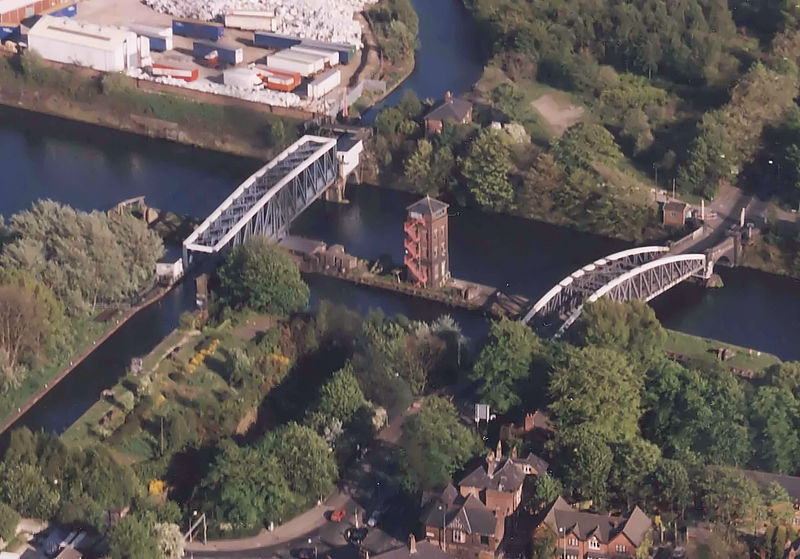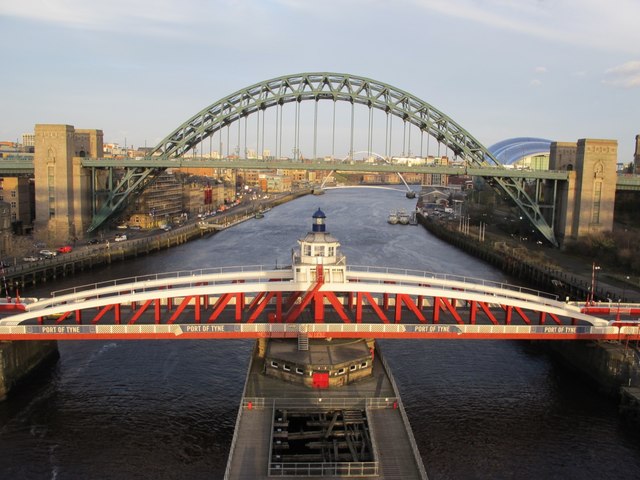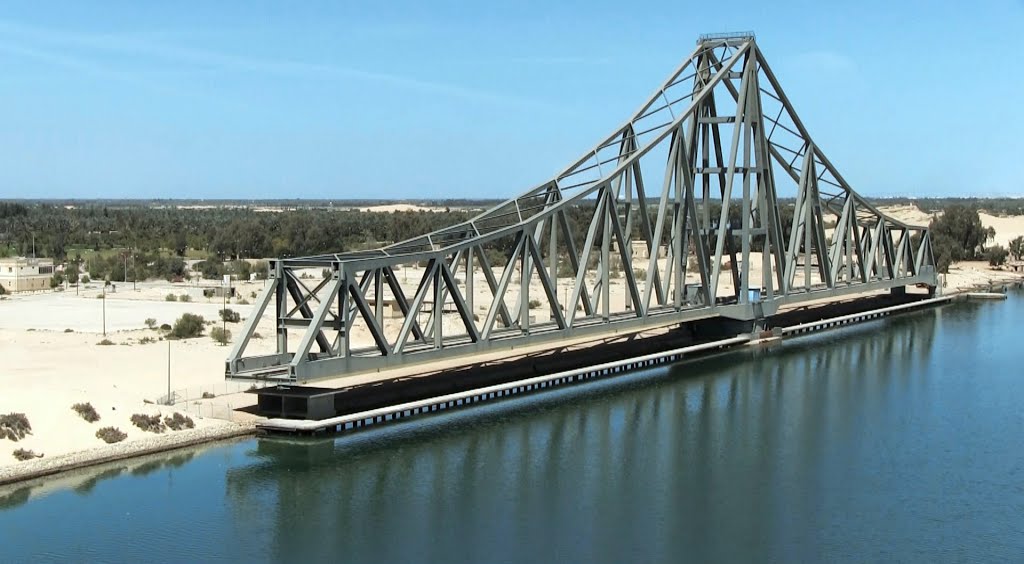Swing bridge

|
| The Barton Swing Road Bridge (pictured on the right) is controlled from a brick tower situated on an adjacent island. The Barton Swing Aqueduct (pictured on the left) is controlled from the same tower. Both were designed and built to pivot open for ships that needed to travel through the Manchester Shipping Canal. |
Contents |
[edit] Introduction
Bridges are a common feature of the built environment and one of the key elements of civil engineering. The basic principles of bridge design are dependent on the load-bearing structure. These are generally beam, arch or suspension structures.
[edit] Movable bridges
Movable bridges are designed in a way that allows them to accommodate different situations and the flow of different types of traffic. One kind of movable bridge is a swing bridge.
While a swing bridge in England is defined under Section 329 of the Highways Act 1980 as, “...any opening bridge operated by mechanical means”, this broad interpretation would include other mechanised opening bridges, such as certain types of drawbridges, lift bridges, retractable bridges and so on. For clarification, a swing bridge is a movable bridge with a deck that rotates around a fixed point, in some instances working in a similar way to a gate.
[edit] How do swing bridges work?
Some swing bridges have two moving parts that swing to the sides. This clears a central channel. Others pivot on a central support, which opens one (or sometimes two) waterway channels.
Swing bridges generally make a one-quarter turn to pivot 90°. However, some may open to smaller angles, depending on the orientation of the bridge and the waterway.
[edit] What do swing bridges do?
These structures are typically used to manage road or rail traffic above busy waterways. When the swing bridge is closed, road or rail traffic can travel freely over the waterway. For busy roads, this is often the default position.
When water traffic needs to pass through, traffic signals or barriers are activated to prevent road traffic from crossing. The bridge is then mechanically activated so it swings or pivots into place, allowing sufficient space and time for boats, barges and other watercrafts to pass through the channel (or channels) safely.
Swing bridges are considered beneficial in certain circumstances, but they can cause issues when controlling the flow of traffic in busy areas. They can also create navigational concerns for large water vessels or inexperienced boat operators.
[edit] Oldest and newest swing bridges in the UK
The oldest swing bridge in the world is the hydraulic Swing Bridge over the River Tyne. This Grade II listed structure is believed to be one of the few remaining 19th century swing bridges still in operation in the UK.

|
| Photo of the Swing Bridge, the Tyne Bridge and the Millennium Bridge in the distance taken from NZ2563, The High Level Bridge. |
Initial designs for the Swing Bridge were drawn up in the 1860s by John Ure, the resident engineer of the Tyne Improvement Commission. These designs would be further developed and financed by the engineer and inventor Sir George R Armstrong (whose company would later devise the mechanisation required to operate London’s Tower Bridge). An earlier bridge on the site was demolished in 1868 and construction of the new bridge was completed in 1876.
The bridge, which requires approximately six minutes to complete a full rotation, underwent a significant renovation in 2018. However, Armstrong’s hydroelectric powered engineering mechanisms have been kept in working order and still operate as originally designed.
The Gateshead Millennium Bridge designed by WilkinsonEyre, is unusual in that it tilts to allow shipping to pass underneath.
In March 2021, plans were announced for a new swing bridge over the River Clyde. The bridge will be designed for vehicles, pedestrians and cyclists and will open at regular intervals to accommodate shipping. The bridge will span from Renfrew to the boundary between Glasgow and West Dunbartonshire. It will have a twin-leaf design - making it a double swing bridge - with each leaf opening and closing horizontally.
[edit] Other noteworthy swing bridges
There are many examples of swing bridges all over the world.

|
| The El Ferdan railway bridge is no longer functional, due to the expansion of the Suez Canal. |
The longest swing bridge in the world is the El Ferdan Bridge in Egypt. This railway bridge has a span of 340 m and crosses the western shipping lanes of the Suez Canal.
Some of the other noteworthy swing bridges in the UK include:
- Aber swing bridge - a pedestrian traffic bridge in Gwynedd, Wales (1970).
- Acton swing bridge - road traffic bridge in north Cheshire, England (1933).
- Barton Road swing bridge - road traffic bridge in Greater Manchester (1894).
- Goole swing bridge (also known as the Skelton Viaduct or the Hook bridge) - railway traffic bridge over the River Ouse, Yorkshire (1869).
- Reedham swing bridge - railway traffic bridge in Reedham, Norfolk (1902).
- Trowse Bridge - railway traffic with an overhead electrified railway track over the River Yare in Norwich (1987).
- Whitby swing bridge - pedestrian and road traffic bridge over the River Esk. Whitby, North Yorkshire, England (1909).
[edit] Related articles on Designing Buildings Wiki
- Bascule bridge.
- Bridge construction.
- Bridges of the world.
- Bridge structures.
- Cantilever.
- Hydroelectricity.
- Movable bridge.
- Navigable aqueduct.
- Pontoon bridge.
- Railway engineering.
- Retractable bridge.
- River engineering.
[edit] External resources
Featured articles and news
RTPI leader to become new CIOB Chief Executive Officer
Dr Victoria Hills MRTPI, FICE to take over after Caroline Gumble’s departure.
Social and affordable housing, a long term plan for delivery
The “Delivering a Decade of Renewal for Social and Affordable Housing” strategy sets out future path.
A change to adoptive architecture
Effects of global weather warming on architectural detailing, material choice and human interaction.
The proposed publicly owned and backed subsidiary of Homes England, to facilitate new homes.
How big is the problem and what can we do to mitigate the effects?
Overheating guidance and tools for building designers
A number of cool guides to help with the heat.
The UK's Modern Industrial Strategy: A 10 year plan
Previous consultation criticism, current key elements and general support with some persisting reservations.
Building Safety Regulator reforms
New roles, new staff and a new fast track service pave the way for a single construction regulator.
Architectural Technologist CPDs and Communications
CIAT CPD… and how you can do it!
Cooling centres and cool spaces
Managing extreme heat in cities by directing the public to places for heat stress relief and water sources.
Winter gardens: A brief history and warm variations
Extending the season with glass in different forms and terms.
Restoring Great Yarmouth's Winter Gardens
Transforming one of the least sustainable constructions imaginable.
Construction Skills Mission Board launch sector drive
Newly formed government and industry collaboration set strategy for recruiting an additional 100,000 construction workers a year.
New Architects Code comes into effect in September 2025
ARB Architects Code of Conduct and Practice available with ongoing consultation regarding guidance.
Welsh Skills Body (Medr) launches ambitious plan
The new skills body brings together funding and regulation of tertiary education and research for the devolved nation.
Paul Gandy FCIOB announced as next CIOB President
Former Tilbury Douglas CEO takes helm.
UK Infrastructure: A 10 Year Strategy. In brief with reactions
With the National Infrastructure and Service Transformation Authority (NISTA).























